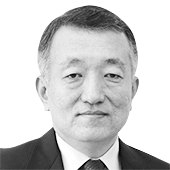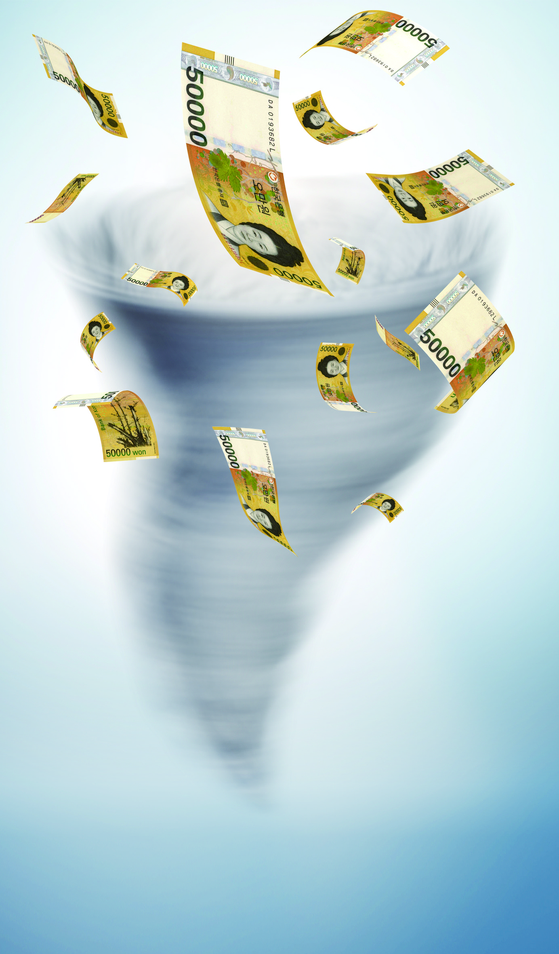Three warnings from the economic front

The author is a senior editorial writer at the JoongAng Ilbo.
There are three indicators of a looming economic crisis. The Korean won’s rate against the Japanese yen is one of them. It can serve as a yardstick as crucial as the rate against the U.S. dollar. When the Federal Reserve raises the base rate, many other major central banks do the same to help contain inflation in their own country and prevent a foreign capital flight. Japan alone has maintained the ultra-loose policy — negative 0.1 percent currently. Tokyo can do that, as inflation has been a lesser problem. The consumer price index in Japan rose 2.5 percent in May on year. The yen is also accepted as a key currency and is internationally tradable, and it is supported by a permanent currency swap deal with America.
The yen is at a 24-year low against the greenback as a result of its ultra-low interest rate. But the Korean won unwittingly has strengthened against the yen. Because Korean products are pitted against Japanese brands in international markets, exports can take a hit if they lose price competitiveness. When trade deficit piles up, a liquidity crisis can hit Korea. In 1994 and 2005, when America lifted the benchmark rate steeply, the yen weakened as expected. Two to three years later, Korea suffered an economic crisis.
The second indicator is the short-term foreign debt ratio against foreign exchange (FX) reserves. Short-term foreign debt refers to obligations due in less than a year to overseas lenders. When the economy slows and sovereign rating is cut, short-term debt increases. In 1997, the ratio hit 657 percent. Since the debt overwhelmed foreign exchange reserves by 6 to 7 times, it is no wonder the country came under a default crisis. After Korea survived the crisis through an international bailout, the ratio came down to a 20 percent range. It shot back up to 74 percent during the 2008 global financial meltdown. The ratio that sank to 28 percent in 2016 has been back on the rise. At 38 percent as of the first quarter, the share was is expected to climb further. Short-term foreign debt reached $174.9 billion in the first quarter, up $10.2 billion from three months earlier. As of June, FX reserves were $438.2 billion, down $31 billion from eight months ago. In June alone, authorities spent $9.4 billion to bolster the won. At the current rate, the short-term foreign debt ratio against the FX reserves could reach 50 percent by the end of the year.
The government and central bank claim that the FX reserve is sufficient. But in 2008, Korea’s FX reserve decreased by $42.7 billion from September to November. If not for a $30 billion currency swap with the U.S., which was signed in November that year, the country’s FX reserves could have thinned at a fast clip. The Bank for International Settlements (BIS) recommends that Korea maintain its FX reserve at $930 billion.

The International Monetary Fund (IMF) sets the recommendable level at $450 billion to $680 billion. Korea’s current FX holdings have fallen short of both thresholds. Korea is a small open market, and the won is not a key currency. Even at greater financing costs, the country better holds sufficient FX reserve, especially under volatile times like these days.
During the summit in May in Seoul, South Korea and the U.S. agreed to closely cooperate on foreign exchange market issues. But Korea has not gotten assurances on a currency swap as the matter is up to the independent Federal Reserve. Some could suggest it is shameful to beg for a currency swap, but pride should not be an issue in such urgent times.
Another important indicator is a trade balance with China.
Korea incurred a deficit in trade with China for the second consecutive month in June. A deficit for two straight months is the first in 28 years. Demand in China collapsed due to a virus-related lockdown in major cities, causing 0.4 percent contraction in the second-quarter growth. China has been reducing imports of intermediary materials for greater self-supply. Such change can bode badly for Korea’s trade prospects. Korea kept up a trade surplus annually for 29 years with China since 1993, the second year after the establishment of diplomatic relations. If exports to China fall, a surplus in the trade balance cannot be ensured.
Senior presidential secretary Choi Sang-mok recently said the country needs to groom alternative markets to China. But that cannot be done overnight. Beijing reportedly has responded sensitively to Choi’s remark on exiting from China. Companies with close business relations in China can be affected. If Seoul irks Beijing without preparation, it can come under China risk like the diesel exhaust fluid and urea crisis the country suffered after Beijing banned exports demonstrated.
All the three indicators are flagging danger signs. The government must raise vigilance. The presidential office must set up an economic war room to command operations to save the economy.
But the Yoon Suk-yeol administration does not show any indication of a sense of urgency. It lacks vision or strategy to fight the crisis. The casual comments Yoon makes in response to questions from reporters on his way to the presidential office can hardly convince the public of his administration’s determination to tackle the challenge.










with the Korea JoongAng Daily
To write comments, please log in to one of the accounts.
Standards Board Policy (0/250자)